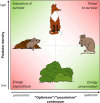Optimism and pessimism: a concept for behavioural ecology
- PMID: 39711313
- PMCID: PMC12120394
- DOI: 10.1111/brv.13178
Optimism and pessimism: a concept for behavioural ecology
Abstract
Originating from human psychology, the concepts of "optimism" and "pessimism" were transferred to animal welfare science about 20 years ago to study emotional states in non-human animals. Over time, "optimism" and "pessimism" have developed into valuable welfare indicators, but little focus has been put on the ecological implications of this concept. Here, we aim to bridge this gap and underline the great potential for transferring it to behavioural ecology. We start by outlining why "optimism" and "pessimism" can be considered as aspects of animal personalities. Furthermore, we argue that considering "optimism"/"pessimism" in a behavioural ecology context can facilitate our understanding of individual adjustment to the environment. Specifically, we show how variation in "optimism"/"pessimism" can play a crucial role in adaptation processes to environmental heterogeneity, for example, niche choice and niche conformance. Building on these considerations, we hypothesise that "optimists" might be less plastic than "pessimists" in their behaviour, which could considerably affect the way they adjust to environmental change.
Keywords: animal personality; environmental change; individualised niche; optimism; pessimism; phenotypic plasticity.
© 2024 The Author(s). Biological Reviews published by John Wiley & Sons Ltd on behalf of Cambridge Philosophical Society.
Figures


Similar articles
-
Optimism/pessimism and associations with life event perceptions.PLoS One. 2025 Apr 1;20(4):e0321128. doi: 10.1371/journal.pone.0321128. eCollection 2025. PLoS One. 2025. PMID: 40168444 Free PMC article.
-
Optimism and pessimism are related to different components of the stress response in healthy older people.Int J Psychophysiol. 2015 Nov;98(2 Pt 1):213-21. doi: 10.1016/j.ijpsycho.2015.09.002. Epub 2015 Sep 5. Int J Psychophysiol. 2015. PMID: 26348260
-
Optimism, Pessimism, Coping, and Depression: A Study on Individuals With Parkinson's Disease.Int J Aging Hum Dev. 2019 Apr;88(3):231-249. doi: 10.1177/0091415018763401. Epub 2018 Mar 20. Int J Aging Hum Dev. 2019. PMID: 29557181
-
Optimism, pessimism, and physical health among youth: a scoping review.J Pediatr Psychol. 2024 Aug 1;49(8):580-595. doi: 10.1093/jpepsy/jsae045. J Pediatr Psychol. 2024. PMID: 38879445 Free PMC article.
-
Optimism in adults born preterm: Systematic review and individual-participant-data meta-analysis.PLoS One. 2021 Nov 18;16(11):e0259463. doi: 10.1371/journal.pone.0259463. eCollection 2021. PLoS One. 2021. PMID: 34793498 Free PMC article.
References
-
- Anderson, M. H. , Hardcastle, C. , Munafò, M. R. & Robinson, E. S. (2012). Evaluation of a novel translational task for assessing emotional biases in different species. Cognitive, Affective, & Behavioral Neuroscience 12, 373–381. - PubMed
-
- Bateson, M. (2016). Optimistic and pessimistic biases: a primer for behavioural ecologists. Current Opinion in Behavioral Sciences 12, 115–121.
-
- Bateson, M. & Matheson, S. M. (2007). Performance on a categorisation task suggests that removal of environmental enrichment induces “pessimism” in captive European starlings (Sturnus vulgaris). Animal Welfare 16(S1), 33–36.
Publication types
MeSH terms
Grants and funding
LinkOut - more resources
Full Text Sources
Miscellaneous

